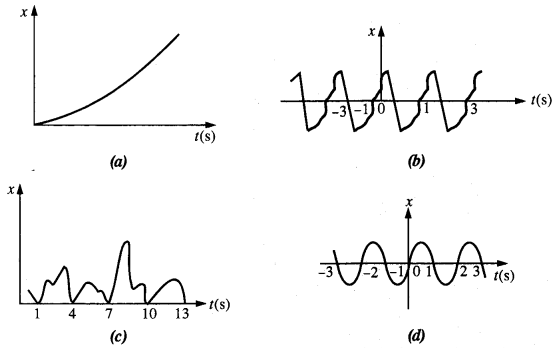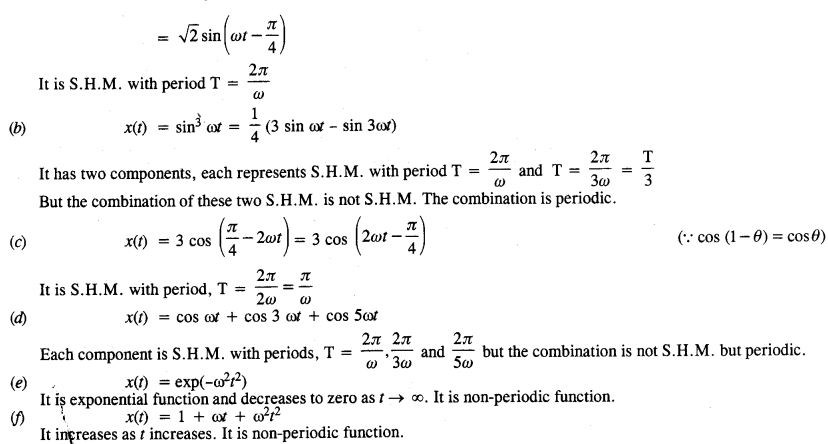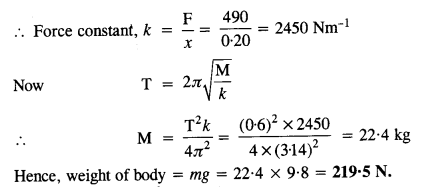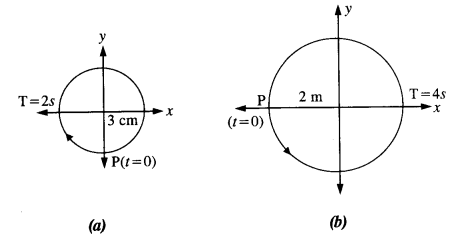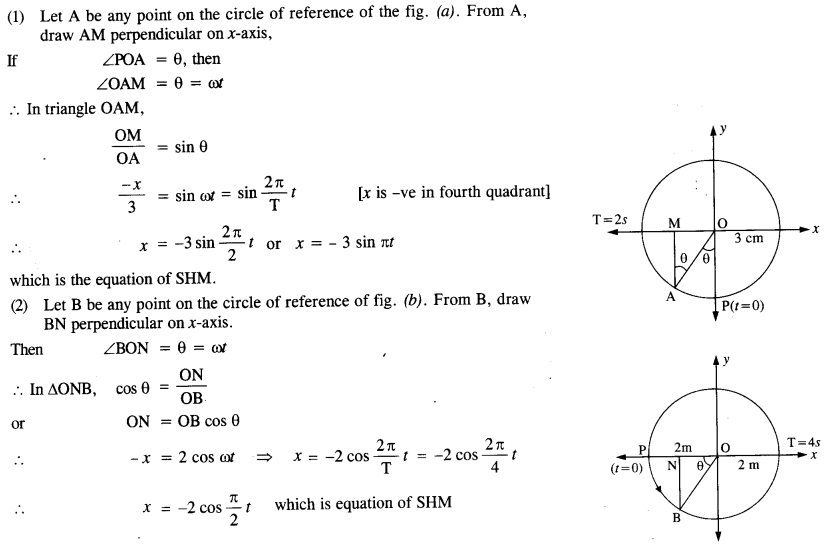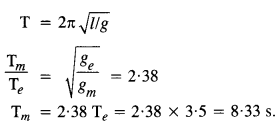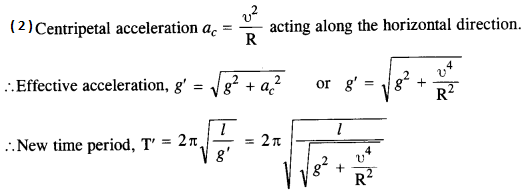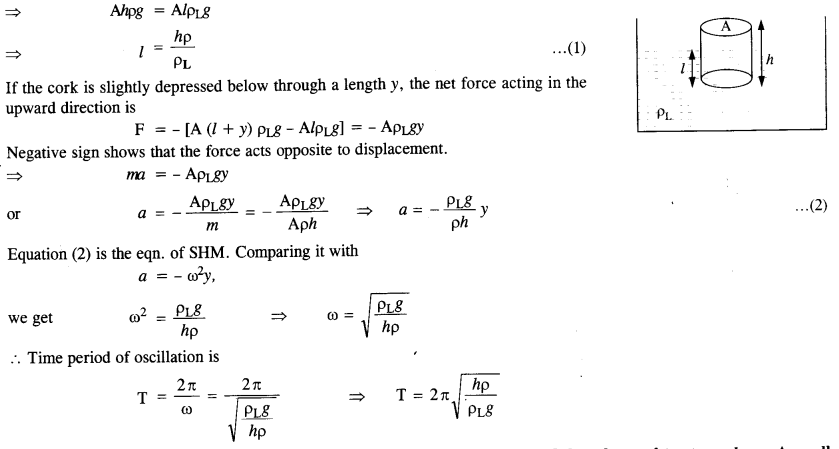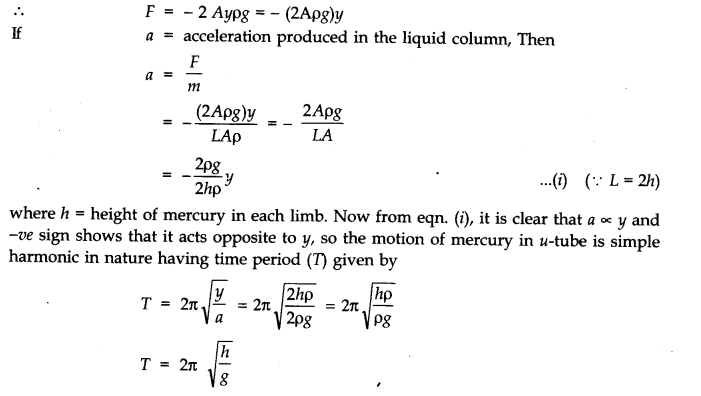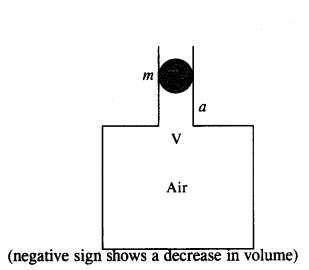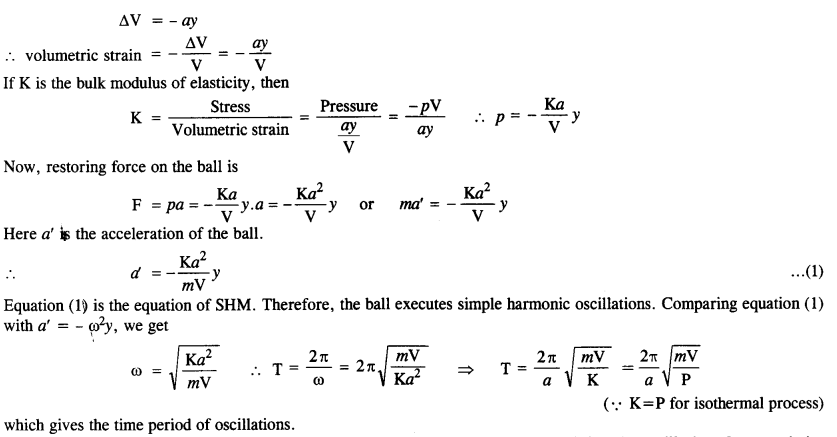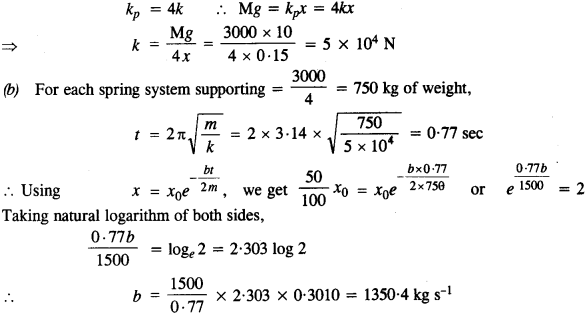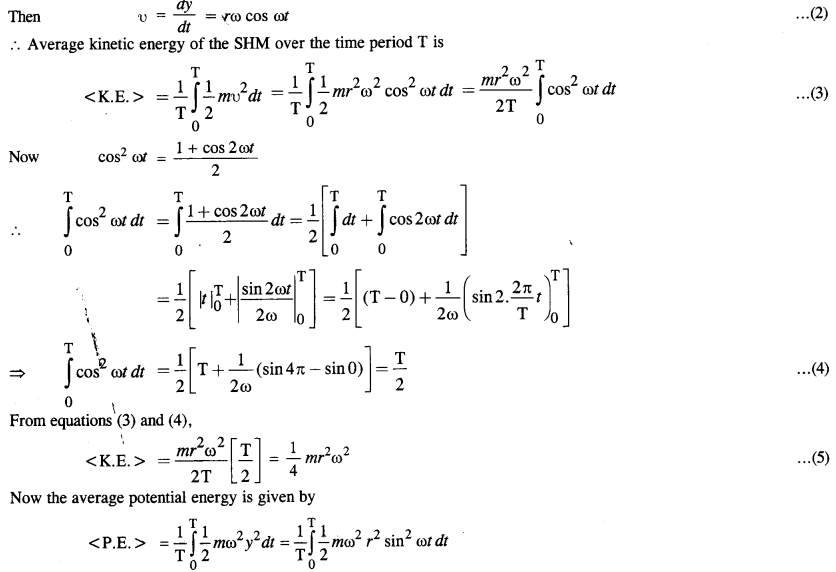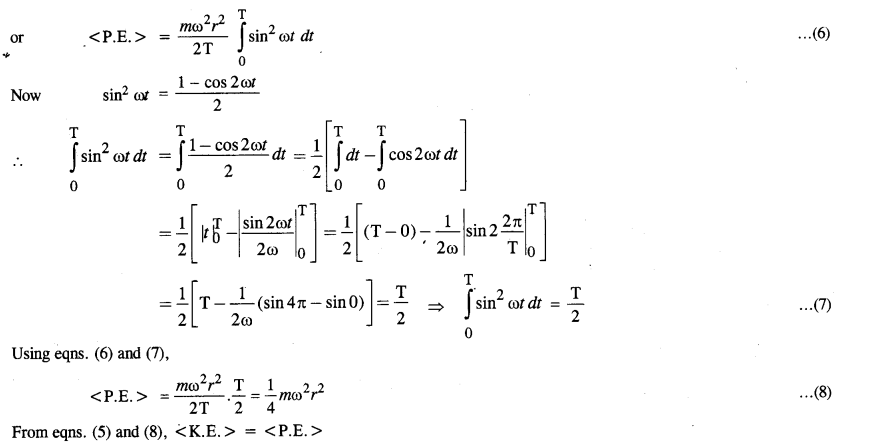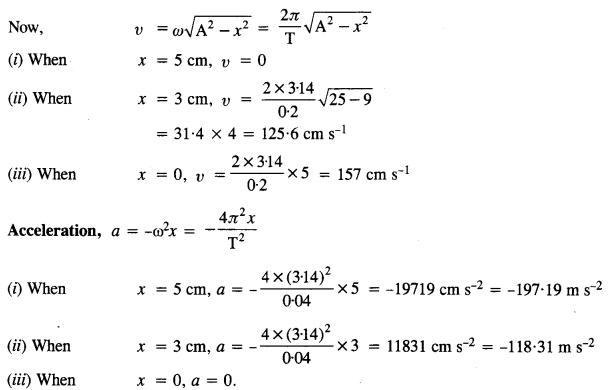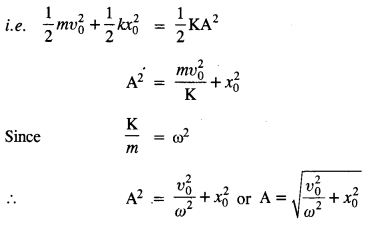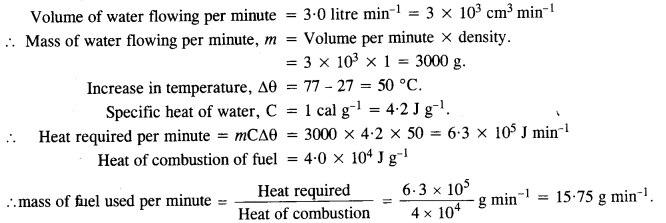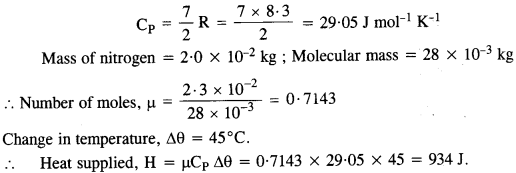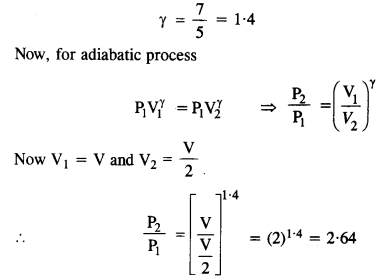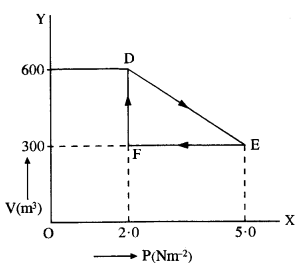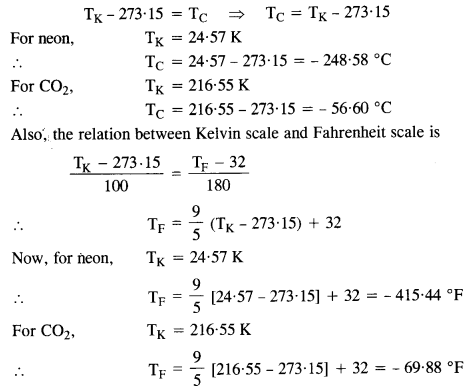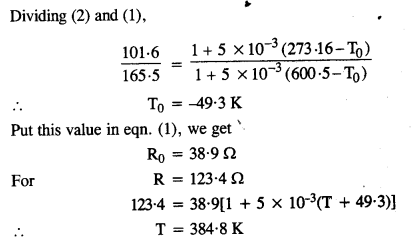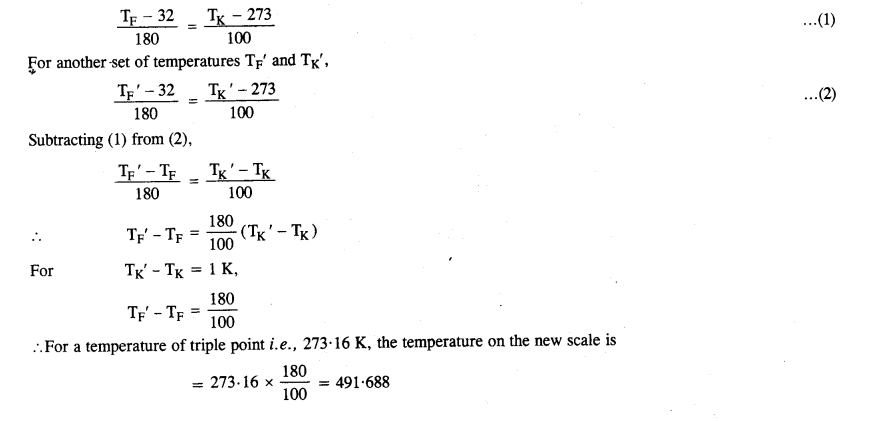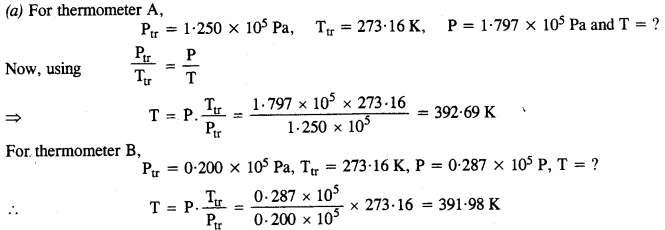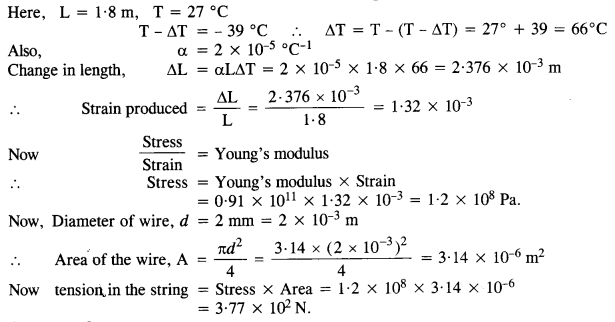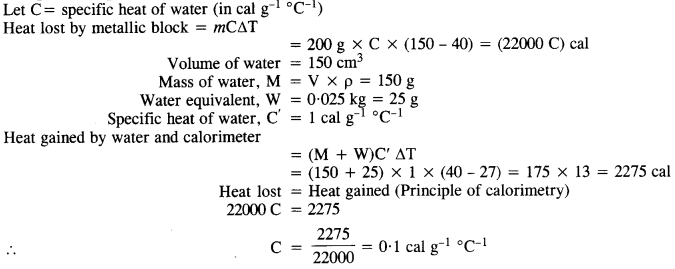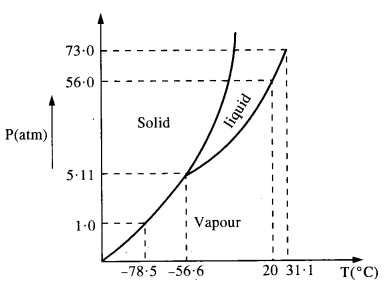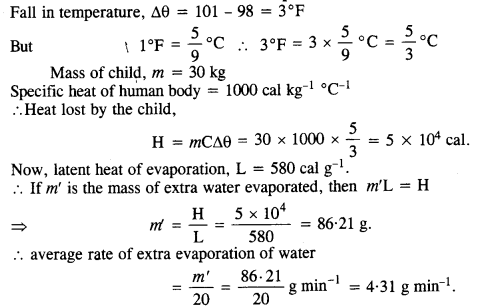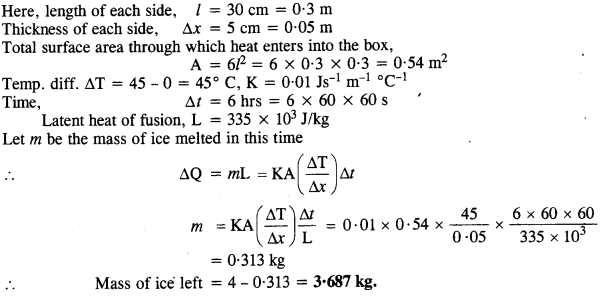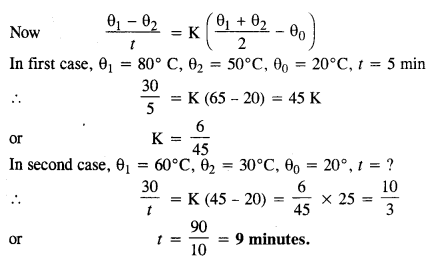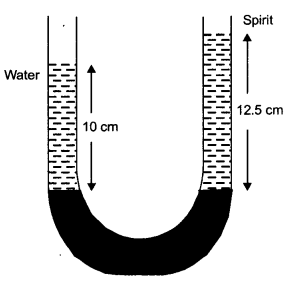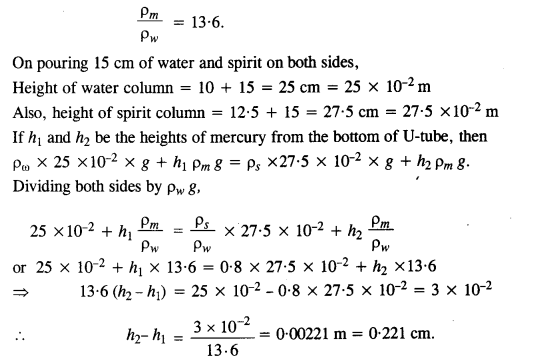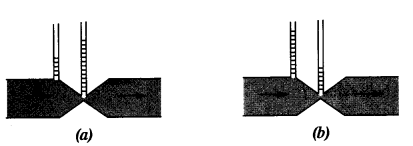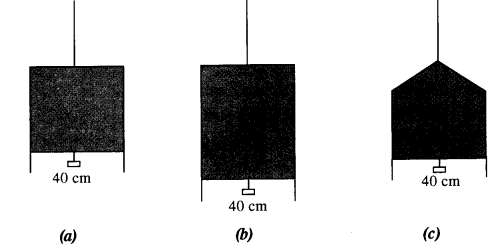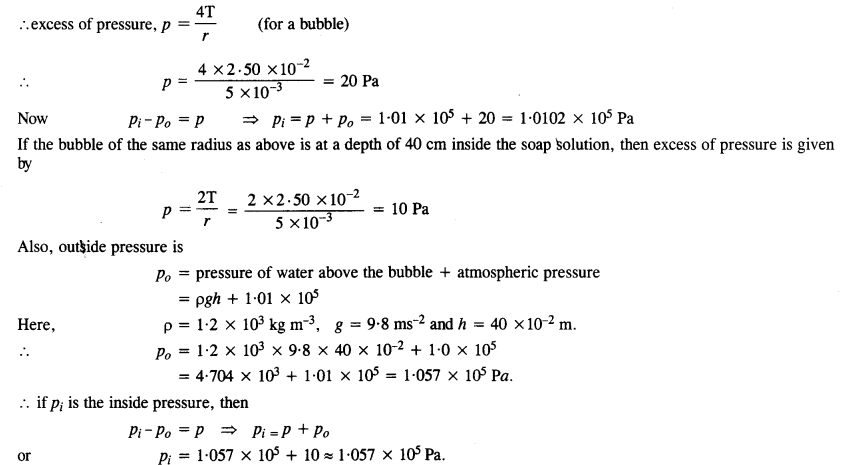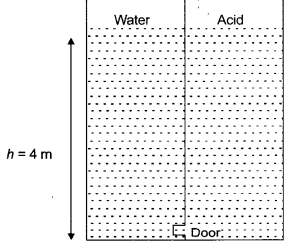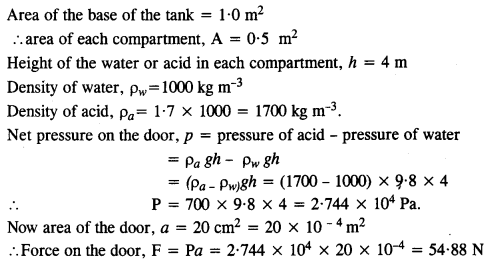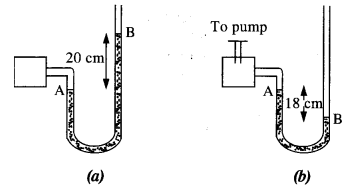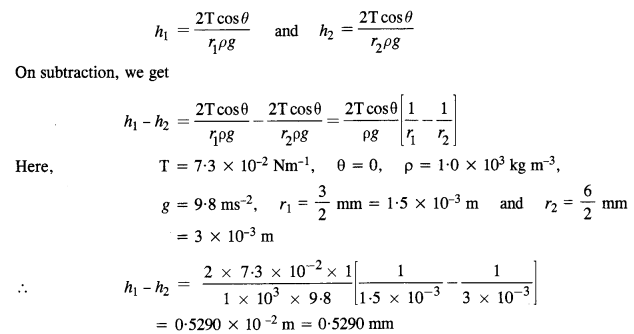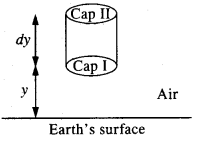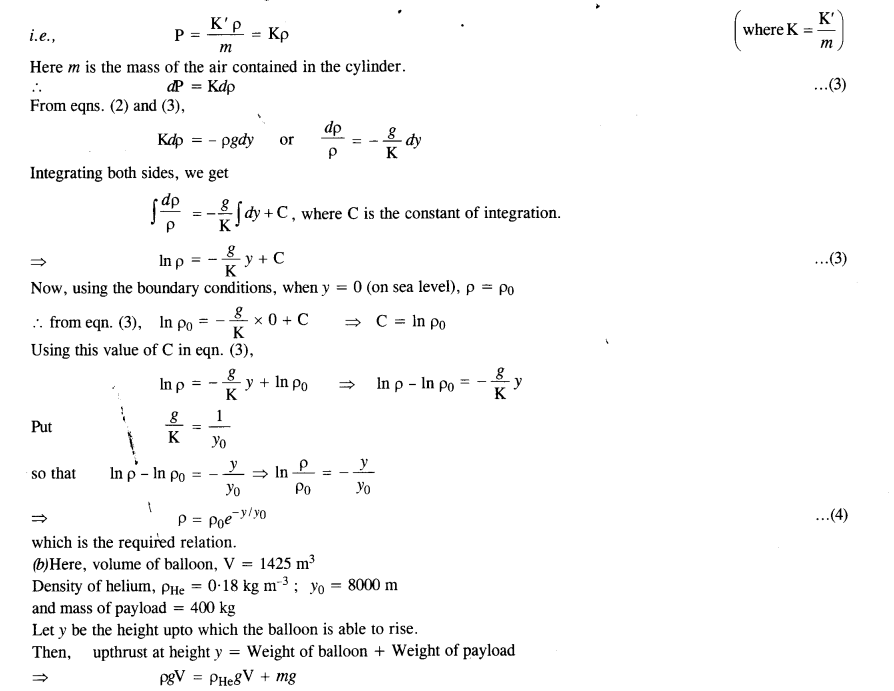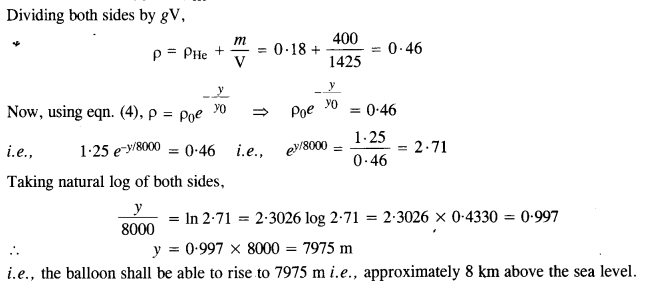NCERT Solutions for Class 11 Physics Chapter 15 Waves
These Solutions are part of NCERT Solutions for Class 11 Physics. Here we have given NCERT Solutions for Class 11 Physics Chapter 15 Waves
Question 1.
A string of mass 2.50 kg is under a tension of 200 N. The length of the stretched string is 20.0 cm. If the transverse jerk is struck at one end of the string, how long does the disturbance take to reach the other end ?
Answer:
Tension in the string, T = 200 N ; Mass of string, M = 2.50 kg ;
Length, l= 20.0 cm = 20 x 10-2 m

Question 2.
A stone dropped from the top of a tower of height 300 m high splashes into the water of a pond near the base of the tower. When is the splash heard at the top? Given that the speed of sound in air is 340 m s-1. (g = 9.8 m s-2)
Answer:
Here, h=300 m, g = 9.8 m s-2 and velocity of sound,υ= 340 m s-1
Let t1 be the time taken by the stone to reach the surface of the pond.
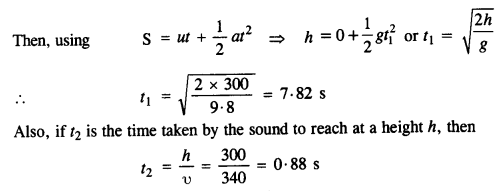
.’. Total time after which sound of splash is heard = t1+ t2= 7.82 + 0.88 = 8.7 s.
Question 3.
A steel wire has a length of 12.0 m and a mass of 2.10 kg. What should be the tension in the wire so that the speed of a transverse wave on the wire equals the speed of sound in dry air at 20°C = 343 m s-1.
Answer:
Mass, M= 2.10 kg, Length, l = 12.0 m.

Question 4.
Use the formula

to explain why the speed of sound in air
(a) is independent of pressure.
(b) increases with humidity.
(c) increases with temperature
Answer:

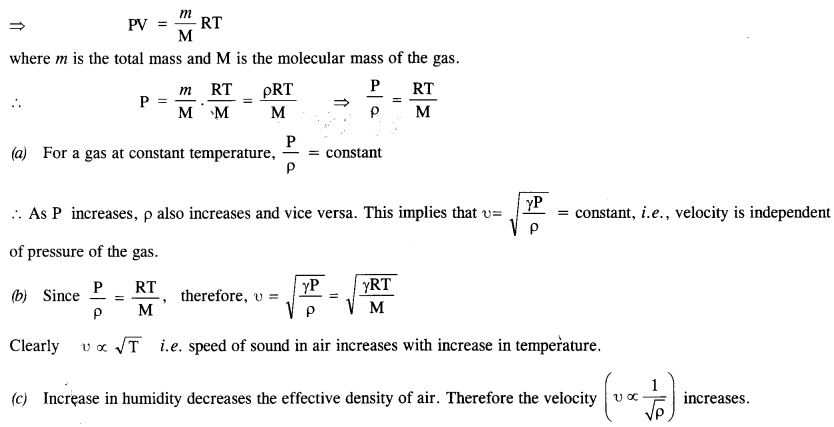
Question 5.
You have learnt that a travelling wave in one dimension is represented by a function y = f(x,t) where x and t must appear in the combination x – υt or x + υt, i.e. y = F(x ± υt.) Is the converse true ? Examine if the following functions for y can possibly represent a travelling wave:
(a) (x – υt)2
(b) log [(x +υt )/x0]
(c)exp [-(x + υt)/x0]
(d) 1/(x + υt)
Answer:
The converse of the above statement is not true. For a function to represent a travelling wave, the function must be finite and well defined at any point and at any time. Only the function (C) satisfies this condition and is a wave function.
Question 6.
A bat emits the ultrasonic sound of frequency 1000 kHz in air. If the sound meets a water surface, what is the wavelength of (a) the reflected sound, (b) the transmitted sound?
Speed of sound in air is 340 m s-1 and in water 1486 m s-1.
Answer:
Here v = 1000 kHz = 1000 x 103 Hz = 106 Hz
Velocity of sound in air, υa = 340 ms-1; the velocity of sound in water, υw = 1486 ms-1
(a) For reflected sound, medium remains the same

Question 7.
A hospital uses an ultrasonic scanner to locate tumours in a tissue. What is the wavelength of sound in the tissue in which the speed of sound is 1.7 km s-1 ? The operating frequency of the scanner is 4.2 MHz.
Answer:
Here,υ = 1.7kms_1 = 1.7 x 1000 ms_1 = 1700 ms_1
Frequency, v= 4.2 MHz = 4.2 X 106 Hz
![]()
Question 8.
A transverse harmonic wave on a string is described by
y (x, t) = 3.0 sin (361 + 0.018 x + π/4) where x and y are in cm and t in s. The positive direction of x is from left to right.
(a) Is this a travelling wave or a stationary wave?
(b) If it is travelling, what are the speed and direction of its propagation?
(c) What are its amplitude and frequency ?|
(d) What is the initial phase at the origin?
(e) What is the least distance between two successive crests in the wave?
Answer:
(a) It is traveling which is propagating from right to left. Comparing the given equation with y (x, t) = r sin (ωt+kr+φ)
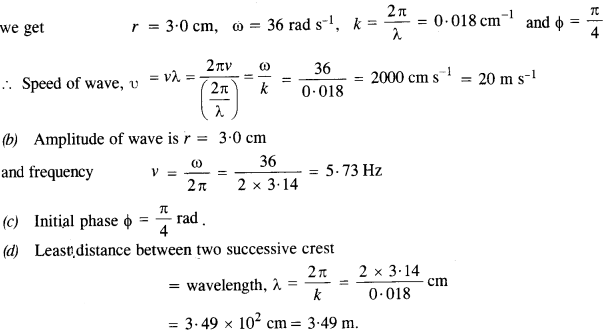
Question 9.
For the wave described in Exercise 8, plot the displacement (y) versus (f) graphs for x = 0, 2, and 4 cm. What is the shape of these graphs? In which aspects do the oscillatory motion in travelling waves differ from one point to another: amplitude, frequency, or phase?
Answer:
The transverse harmonic wave is
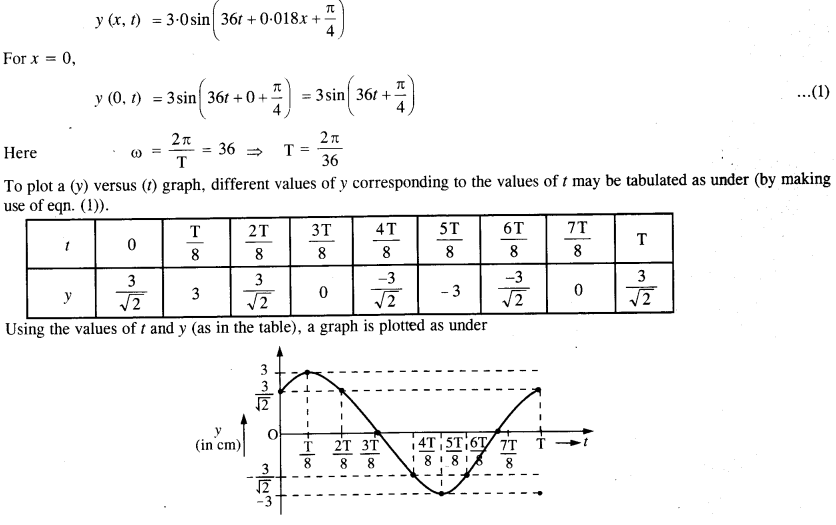
The graph obtained is sinusoidal. Similar graphs are obtained for x = 2 cm and x = 4 cm. The oscillatory motion in the travelling wave only differs in respect of phase. The amplitude and frequency of oscillatory motion remain the same in all the cases.
Question 10.
For the traveling harmonic wave
y (x, t) = 2.0 cos 2π(10t – 0.0080 x + 0.35)
where x and y are in cm and t in s. Calculate the phase difference between the oscillatory motion of two points separated by a distance of
(a)4 m
(b) 0.5 m
(c) λ/2
(d) 3λ/4.
Answer:
Comparing the equation given in the question, with the standard equation of travelling wave:
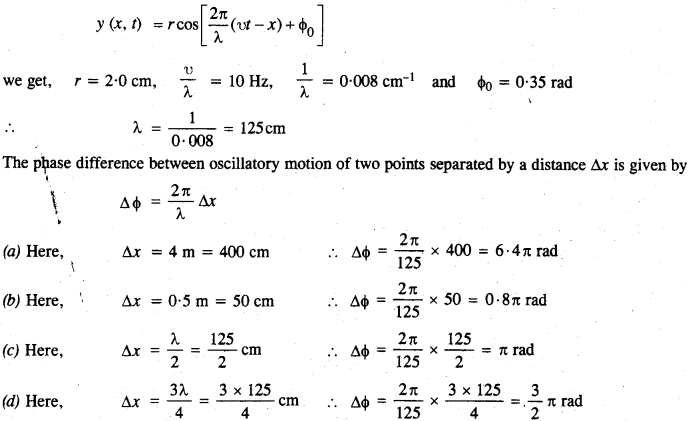
Question 11.
The transverse displacement of a string (clamped at its both ends) is given by
![]()
where x and y are in m and t in s. The length of the string is 1.5 m and its mass is 3.0 x 10-2 kg.
Answer the following:
(a) Does the function represent a travelling wave or a stationary wave?
(b) Interpret the wave as a superposition of two waves traveling in opposite directions. What are the wavelength, frequency, and speed of each wave?
(c) Determine the tension in the string.
Answer:
(a) The function does not represent a travelling wave. It represents a stationary wave.
(b) Using the relation

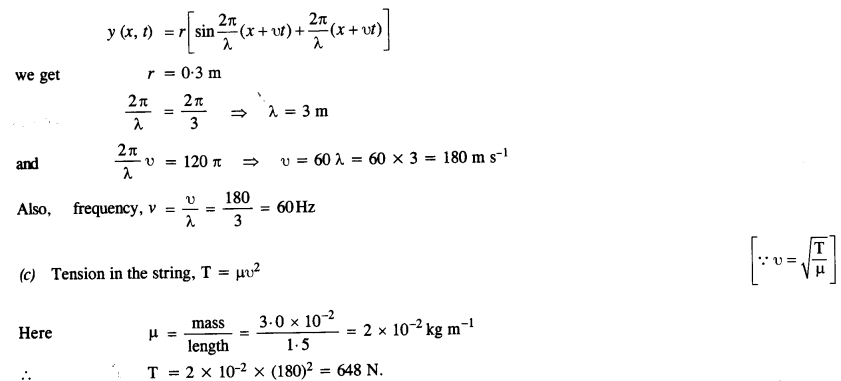
Question 12.
(1) For the wave on a string described in Exercise 11, do all the points on the string oscillate with the same (a) frequency, (b) phase, (c) amplitude? Explain your answers, (2) What is the amplitude of a point 0.375 m away from one end?
(a) All the points on the wave have
(b) same frequently everywhere except at the nodes.
(c) same phase everywhere in a loop except at the nodes.
(d) different amplitude.
(2) Here, x = 0.375 m, 1 = 0
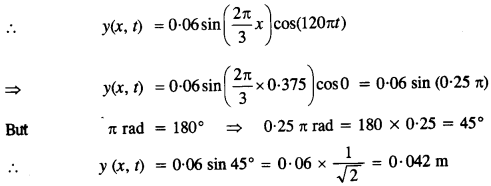
Question 13.
Given below are some functions of x and y to represent the displacement (transverse or longitudinal) of an elastic wave. State which of these represent
(1) a travelling wave,
(2) a stationary wave or
(3) none at all:
(a) y = 2 cos (3x) sin (10t)
(b)![]()
(c) y = 3 sin (5x – 0.5t) + 4 cos (5x – 0.5t)
(d) y = cos x sin t- cos 2x sin 2t
Answer:
(a) It represents a stationary wave.
(b) It does not represent either a travelling wave or a stationary wave.
(c) It is a representation of the travelling wave.
(d) It is a superposition of two stationary waves.
Question 14.
A wire stretched between two rigid supports vibrates in its fundamental mode with a frequency of 45 Hz. The mass of the wire is 3.5 x 10-2 kg and its linear density is
4.0 x 10-2 kg m_1. What is
(a) the speed of a transverse wave on the string, and
(b) the tension in the string?
Answer:
Here, v = 45 Hz ; mass of wire, M = 3.5 x 10-2 kg
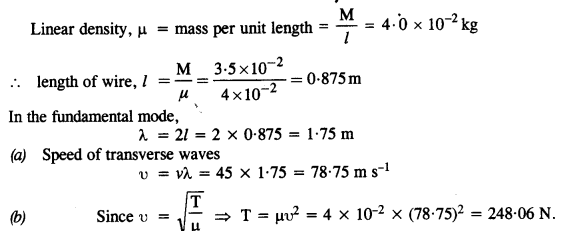
Question 15.
A meter-long tube open at one end, with a movable piston at the other end, shows resonance with a fixed frequency source (a tuning fork of frequency 340 Hz) when this tube length is 25.5 cm or 79.3 cm. Estimate the speed of sound in the air at the temperature of the experiment. The edge effects may be neglected.
Answer:
Let v be the fundamental frequency of the closed-end organ pipe for the length
lx = 25.5 cm
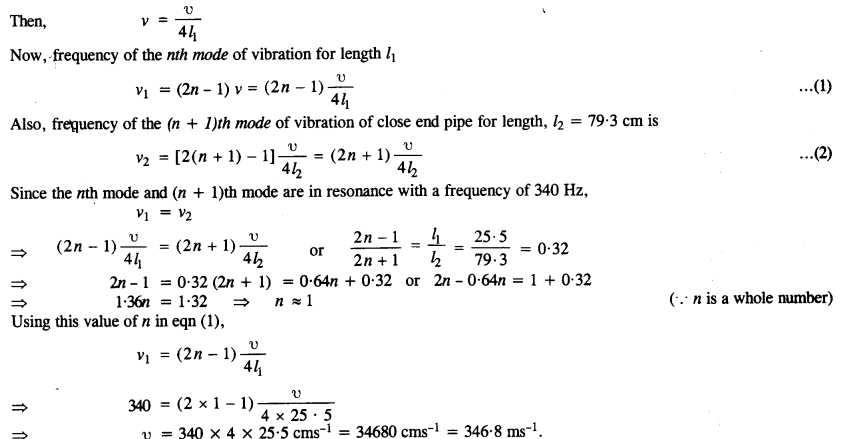
Question 16.
A steel rod 100 cm long is clamped at its middle. The fundamental frequency of longitudinal vibrations of the rod are given to be 2.53 kHz. What is the speed of sound in steel?
Answer:
l = 100 cm = 1 m f = 2.53 kHz
Since the rod is champed at the middle, a node is formed and since the rod is oscillating at a fundamental frequency of 2.53 kHz antinodes are formed at both ends as shown in the figure.
∴ l = λ/4 × 2 = λ/2 ⇒ λ = 2l
λ = 2 × 1 = 2 cm
We know that
v = fλ = 2.53 × 103 × 2
= 5.06 × 10 3 ms-1
Question 17.
A pipe 20 cm long is closed at one end. Which harmonic mode of the pipe is resonantly excited by a 430 Hz source? Will the same source be in resonance with the pipe if both ends are open? (speed of sound in air is 340 ms-1).
Answer:

This is the first harmonic. The second harmonic is 3v i.e., 1275 Hz, the third harmonic is 5v i.e., 2125 Hz etc. Therefore, only the first harmonic of frequency 425 is rasonantly excited by a 430 Hz source.If both the ends of the pipe are open, the fundamental frequency is given by
![]()
The second, third, fourth… etc. harmonics have frequencies 2v’, 3v’, 4v’……. i.e., 1700 Hz, 2550 Hz, 3400 Hz etc.No harmonic can be excited by the 430 Hz source in this case.
Question 18.
Two sitar strings A and B playing the note ‘Ga’ are slightly out of tune and produce beats of frequency 6 Hz. The tension in string A is slightly reduced and the beat frequency is found to reduce to 3 Hz. If the original frequency of A is 324 Hz, what is the frequency of B?
Answer:
Let v1 and v2 be the frequencies of strings A and B respectively
Then, v1= 324 Hz, v2 = ?
Number of beats, b = 6
v2 = v1± b = 324 ± 6
i.e., v2 = 330 Hz or 318Hz.
Since the frequency is directly proportional to square root of tension, on decreasing the tension in the string A, its frequency v1; will be reduced i.e., number of beats will increase if v2 = 330 Hz. This is not so because a number of beats becomes 3. Therefore, it is concluded that the frequency v2 = 318 Hz because on reducing the tension in string A, its frequency may be reduced to 32l Hz, thereby giving 3 beats with v2 = 318 Hz.
Question 19.
Explain why (or how) :
(a) in a sound wave, a displacement node is a pressure antinode and vice versa.
(b) bats can ascertain distances, directions, nature and sizes of the obstacles without any “eyes”.
(c) a violin note and sitar note may have the same frequency, yet we can distinguish between the two notes.
(d) solids can support both longitudinal and transverse waves, but only longitudinal waves can propagate in gases, and
(e) The shape of a pulse gets distorted during propagation in a dispersive medium.
Answer:
(a) In a sound wave, a decrease in displacement i..e. displacement node causes an increase in the pressure there i.e, a pressure antinode is formed. Also, an increase in displacement is due to the decrease in pressure.
(b) Bats emit ultrasonic waves of high frequency from their mouths. These waves after being reflected back from the obstacles on their path are observed by the bats. These waves give them an idea of distance, direction, nature and size of the obstacles.
(c) The quality of a violin note is different from the quality of sitar. Therefore, they emit different harmonics which can be observed by human ear to differentiate between the two notes.
(d) This is due to the fact that gases have only the bulk modulus of elasticity whereas solids have both, the shear modulus as well as the bulk modulus of elasticity.
(e) A pulse of sound consists of a combination of waves of different wavelength. In a dispersive medium, these waves travel with different velocities giving rise to the distortion in the wave.
Question 20.
A train, standing at the outer signal of a railway station blows a whistle of frequency 400 Hz in still air. (1) What is the frequency of the whistle for a platform observer when the train (a) approaches the platform with a speed of 10 ms-1, (b) recedes from the platform with a speed of 10 ms-1 ? (2) What is the speed of sound in each case ? The speed of sound in still air can be taken as 340 ms-1.
Answer:
Here, frequency of whistle, v = 400 Hz,
Speed of sound, v = 340 ms-1; Speed of train, vs = 10 m s-1,
(1) (a) When the train approaches the platform i.e., the observer at rest,

Question 21.
A train, standing in a station-yard, blows a whistle of frequency 400 Hz in still air. The wind starts blowing in the direction from the yard to the station at a speed of 10 ms-1. What are the frequency, wavelength, and speed of sound for an observer standing on the station’s platform? Is the situation exactly identical to the case when the air is still and the observer runs towards the yard at a speed of 10 ms-1? The speed of sound in still air can be taken as 340 ms-1.
Answer:
Frequency of source of the sound, v = 400 Hz.
Speed of sound, υ= 340 ms-1; Speed of wind, υm = 10 ms-1.
Effective speed of sound = Speed of sound + Speed of air
= υ + υm = 340 + 10 = 350 ms-1.
The source, as well as the listener, are both at rest. Therefore, there is no relative motion.

Since the source of sound is at rest, the wavelength A does not change
.’. wavelength = 0.875 m.
Also, speed of sound = 340 + 0 = 340 ms-1
The situations are altogether different, because both the observer and the source are in motion with respect to the medium in this case.
Question 22.
A traveling harmonic wave on a string is described by
y (x,t) = 7.5 sin (0.0050 x + 12t + π/4)
(a) What are the displacement and velocity of oscillation of a point at x = 1 cm, and t = 1 s? Is this velocity equal to the velocity of wave propagation?
(b) Locate the points of the string which have the same transverse displacements and velocity as the x = 1 cm point at t = 2s, 5s, and 11s.
Answer:
The traveling harmonic wave is
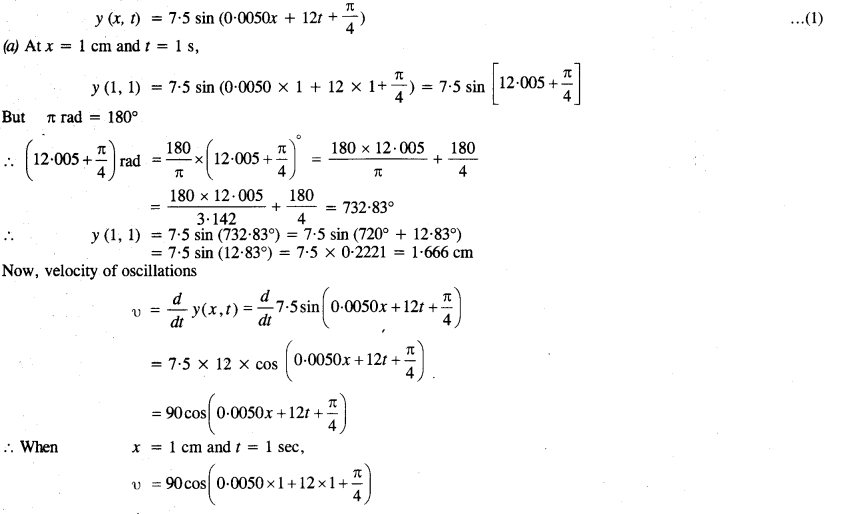
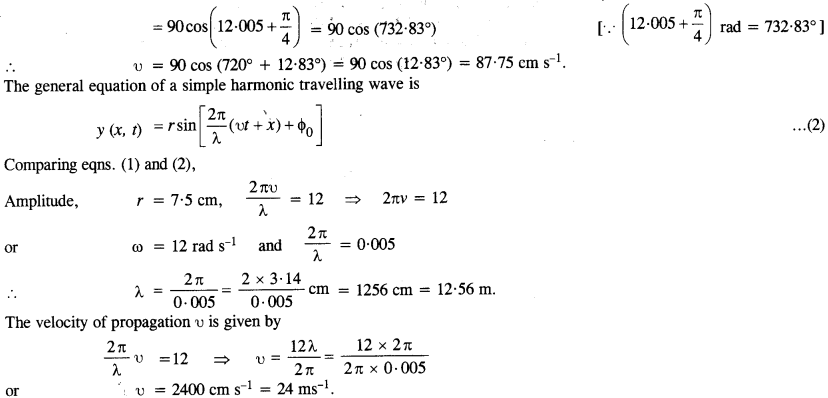
(b) All the point, located at distance nλ, (where n is an integer) from the point x = 1 have the same velocity and displacement.
Question 23.
A narrow sound pulse (for example, a short pip by a whistle) is sent across a medium, (a) Does the pulse have a definite (1) frequency, (2) wavelength, (3) speed of propagation ? (b) If the pulse rate is 1 after every 20 s, (that is the whistle is blown for a split of second after every 20 s), is the frequency of the note produced by the whistle equal to 1/20 or 0.05 Hz? 1
Answer:
1. The pulse does not have a definite frequency and definite wavelength but has a definite speed of propagation.
2. The frequency of the note is not 1/20 Hz or 0.05 Hz. It is only the frequency of repetition of the whistle.
Question 24.
One end of a long string of linear mass density 8.0 x 10-3 kg m-1 is connected to an electrically driven tuning fork of frequency 256 Hz. The other end passes over a pulley and is tied to a pan containing a mass of 90 kg. The pulley end absorbs all the incoming energy so that reflected waves at this end have negligible amplitude. At t = 0, the left end (fork end) of the string x = 0 has zero transverse displacement (y = 0) and is moving along positive y- direction. The amplitude of the wave is 5.0 cm. Write down the transverse displacement y as function of x and t that describes the wave on the string.
Answer:
Here, mass per unit length, m = linear mass density = 8 x 10-3 kg m3.
Tension in the string, T = 90 kg = 90 x 9.8 = 882 N
Frequency, v = 256 Hz ; Amplitude, r = 5.0 cm = 5 x 10-2 m. Hz
The wave produced in the string has velocity υ given by
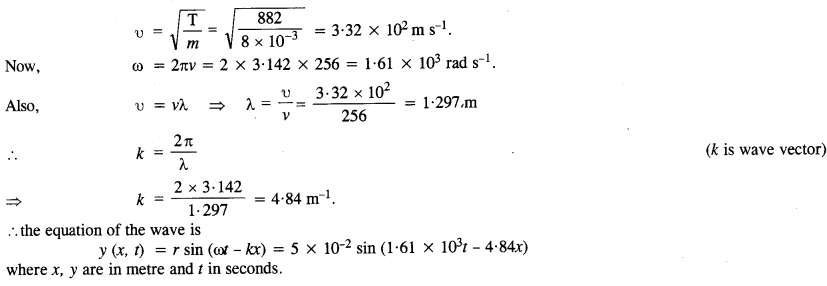
Question 25.
A SONAR system fixed in a submarine operates at a frequency of 40.0 kHz. An enemy submarine moves towards the SONAR with a speed of 360 km h-1. What is the frequency of sound reflected by the submarine? Take the speed of sound in water to be 1450 ms-1.
Answer:
Here, frequency of SONAR(source )=40.0 kHz = 40 x103

Question 26.
Earthquakes generate sound waves inside the earth. Unlike a gas, the earth can experience both transverse (S) and longitudinal (P) sound waves. Typically the speed of the S wave is about 4.0 kms-1, and that of P wave is 8.0 kms-1. A seismograph records P and S waves from an earthquake. The first P wave arrives 4 min before the first S wave. Assuming the waves travel in a straight line, how far away does the earthquake occur?
Answer:
Let υ1 and υ2 be the velocities of two waves respectively and t1 and t2 is the time taken by them to travel to the position of a seismograph.
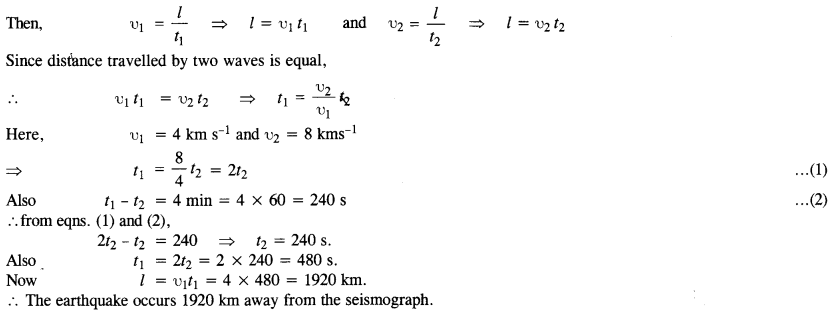
Question 27.
A bat is fitting about in a cave, navigating via ultrasonic bleeps. Assume that the sound emission frequency of the bat is 40 kHz. During one fast swoop directly toward a flat wall surface, the bat is moving at 0.03 times the speed of sound in air. What frequency does the bat hear reflected off the wall ?
Answer:
Here, frequency of sound emitted by bat, v = 40 kHz
Velocity of bat υs= 0.03 u, where 0 is the velocity of sound.
The bat is moving towards the flat wall. This is the case of source in motion and the observer at rest. Therefore, the frequency of sound reflected at the wall is

The frequency v’ is reflected by the wall and is again received by the bat moving towards the wall. This is the case of an observer moving towards the source with velocity
υ0= 0.03υ.
.’. frequency observed by bat,

We hope the NCERT Solutions for Class 11 Physics Chapter 15 Waves, help you. If you have any query regarding NCERT Solutions for Class 11 Physics Chapter 15 Waves, drop a comment below and we will get back to you at the earliest.
